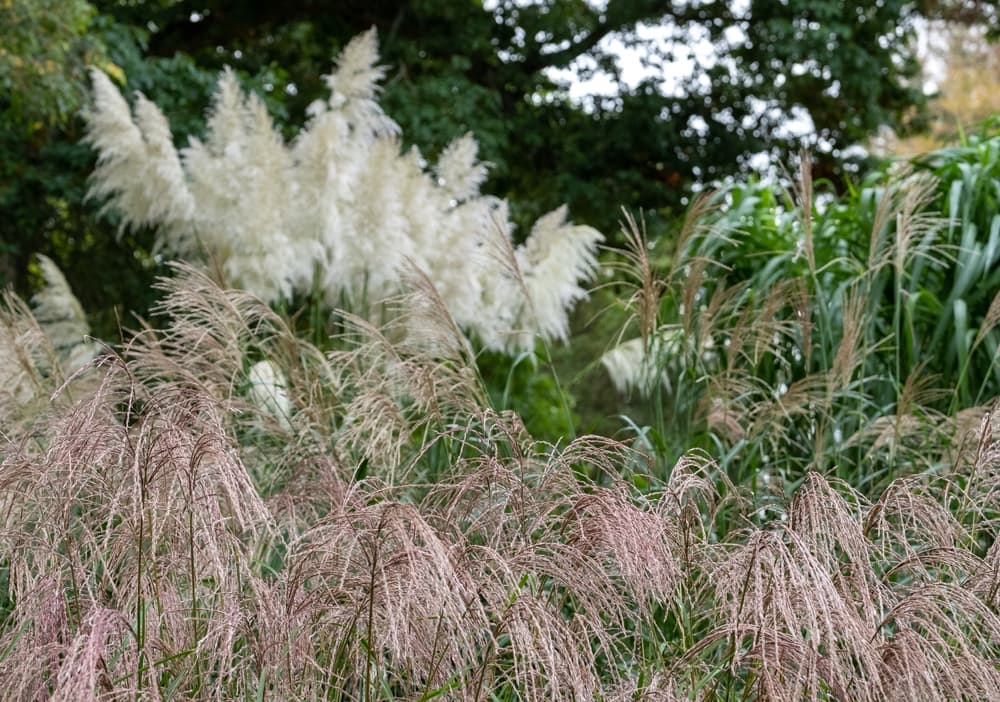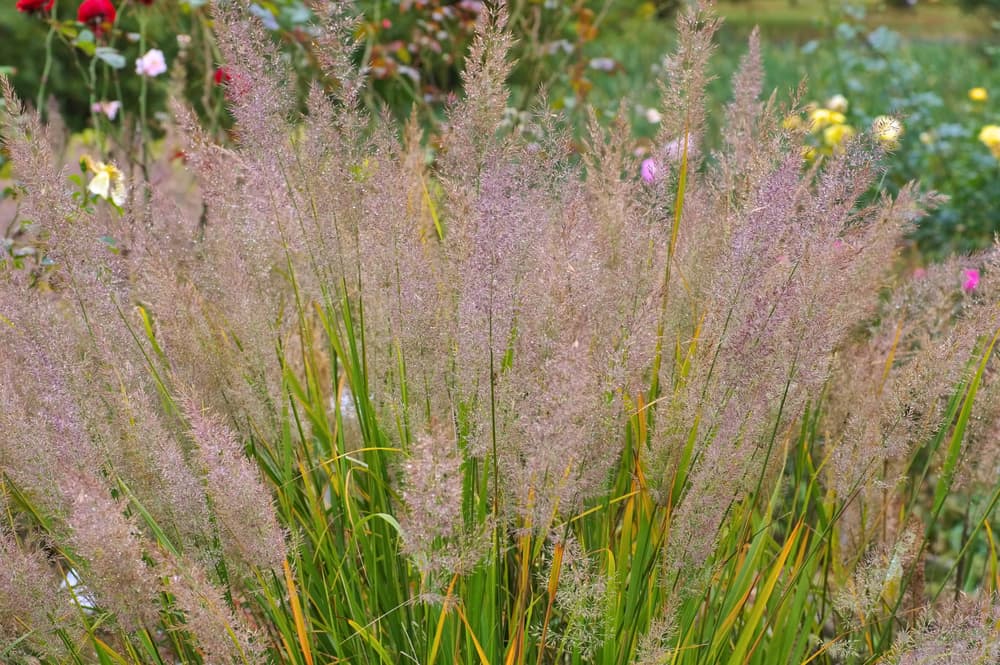Horticulturists Share 10 Ornamental Grass Types For Movement In The Garden


Elizabeth is a Permaculture Garden Designer, Sustainability Consultant and Professional Writer, working as an advocate for positive change. She graduated from the University of St. Andrews with an MA in English and Philosophy and obtained a Diploma in Applied Permaculture Design from the Permaculture Association.
Reviewed By COLIN SKELLY

Colin is a Horticulturist and Horticultural Consultant with experience in a range of practical and managerial roles across heritage, commercial and public horticulture. He holds the Royal Horticultural Society’s Master of Horticulture award and has a particular interest in horticultural ecology and naturalistic planting for habitat and climate resilience.
Contributions From HAYLEY WILLERTON

Hayley Willerton is the owner of The Alpine and Grass Nursery, a specialist plant nursery based in Lincolnshire. She has been growing alpines and grasses for over 20 years and has won multiple Gold Medals at various RHS Flower Shows.

Danny Clarke ('The Black Gardener') is a British Horticulturist and Garden Designer. He is probably best known for his TV presenting roles on the BBC's Instant Gardener, his time on the ITV This Morning team and Filthy Garden SOS aired on Channel 5. He also co-directs CIC Grow 2 Know, a charitable organisation encouraging diversity in horticulture.

Neil Lucas in a leading expert on ornamental grasses and the Director and Owner of Knoll Gardens, based in Dorset. He is also a Council Member for the RHS and has won 10 Gold Medal awards at RHS Shows, including the Chelsea Flower Show. Neil has written two books on grasses and their uses in the garden, including Designing With Grasses.
Choosing ornamental grasses for your garden can be a great way to add drama and style.
“I love ornamental grasses for the softness and movement they can provide in a garden,” Manoj Maldé, award-winning Garden Designer, says.
We offer some things to think about when choosing ornamental grasses in the UK – help you think about why and where you might use them in your garden, while exploring ten of the best ornamental grasses to consider.
To help inform this guide we interviewed Hayley Willerton, the Owner of The Alpine and Grass Nursery.
“I love their versatility, low maintenance, drought tolerance and amazing range that can suit both a large garden and a small trough,” says Hayley, when asked why she is so passionate about growing grasses.
“There’s a grass for everyone.”
Choosing Ornamental Grasses

“I’ve spent most of my life training myself not to have favourites because I have to adapt to the locations in which I’m growing my plants, so I can’t be biased about which ones I love,” shares Neil Lucas, an ornamental grass specialist.
“Having said that, there are always plants that you love.”
When choosing ornamental grasses for your garden, you should consider:
- Whether you want annual or perennial grasses.
- If evergreen or deciduous species are right for you.
- Sunlight and shade conditions in the area where the grass is to grow.
- What type of soil you have, and its characteristics.
- If you want an ornamental grass to grow in the ground or in containers.
“I’m a big fan of grasses,” says TV Presenter and Garden Designer Danny Clarke.
“They give you some movement in a garden, which also gives an added touch of sense.
“The sound of the grass in the breeze is great.”
“In containers, it’s a good idea to choose grasses that will keep their shape, combine well with others and stay evergreen for an all-year-round display,” says Hayley.
“Whilst those in the ground will draw water from the soil, those planted in containers will require regular watering, especially in drier times.”
“When watering grasses, it is best to do this early in the day so that their leaves get a chance to dry out during the day.

“For success when planting grasses into the garden, it is important to consider whether the grasses you choose are cool season grasses, such as Carex testacea and Stipa tenuissima, or warm season grasses, such as Panicum virgatum ‘Shenandoah’ and Calamagrostis brachytricha.
“Warm-season grasses are best planted when the average daily temperatures have started to rise, whereas the cool-season types can be planted much earlier.”
Neil is also a fan of Panicum grasses, as he shares:
“My current favourite plant is Panicum amarum ‘Sea Mist’, which is a Knoll Gardens introduction and I’m really delighted at how it looks in the garden.”
So, if you’ve decided ornamental grasses are right for your garden – which should you choose?
“Some of my personal favourites are Pennisetum macrourum, Hakonechloa macra and Calamagrostis varia,” says Manoj.
Here are ten more genera that could provide the answers you are looking for and help you to find the right plants for the right places:
1) Carex

Technically a sedge rather than a grass, Carex has flowering stems that are triangular and solid rather than round and hollow in cross-section.1Uyterhoeven, S. (2011, November 11). Sedges and Grasses. Plant Talk. Retrieved March 28, 2023, from https://www.nybg.org/blogs/plant-talk/2011/11/tip-of-the-week/sedges-and-grasses/
But this plant is grass-like and often grouped in and categorised with ornamental grasses.
The arching leaves of these plants, produced in clumps, can vary dramatically in colour and can have different edging or stripes.
Most carex will prefer consistently moist soil in sun or light shade, but there are a few which like wet soil, and others that thrive in acid conditions.

“Most grasses will not cope with shade or prolonged damp but Carex really expands the range of options for grass-like planting in these conditions,” says RHS Master Horticulturist Colin Skelly.
“I like to grow Carex divulsa and C. remota in damp shade because I like the natural feel that they provide and because they are very tolerant of a range of conditions.
“There are variegated options of Carex as well and the genera Luzula and Acorus also provide attractive options in similar conditions.”
Carex to consider include:
- C. comans ‘Bronze Leaved’
- C. dipsacea ‘Dark Horse’
- C. elata ‘Aurea’ (Pictured above)
- C. oshimensis ‘Evergold’
- C. siderosticta ‘Variegata’
2) Stipa

Stipa is a genus of grasses that provides several more great options for UK gardens.
These are perennial grasses that have fluffy, feathery or oat-like flowering beds.
Some are deciduous, and some are evergreen.
They come in various sizes and so can work well in many gardens.

Stipa tenuissima (Syn. Nasella tenuissima), Mexican feather grass, is a deciduous ornamental grass forming tufts of thread-like leaves that are around 60cm in height.
It has narrow, arched panicles of feather-like flowers in the summer.
It will grow well in any medium or light, moderately moist yet well-drained soil in full sun.
Other Stipa to consider include:
- S. gigantea ‘Pixie’ (Golden oats ‘Pixie’)
- S. gigantea ‘Gold Fontaene’ (Golden Oats ‘Gold Fontaene’)
- S. calamagrostis (Rough Feather Grass)
- S. pseudoichu
- S. ichu (Syn. Jarava ichu)
3) Pennisetum

Commonly known as ‘fountain grasses’, this is another type of ornamental grass well worth considering in a UK garden.

Pennisetum orientale ‘Fairy Tails’ is a perennial, deciduous grass that can grow up to around 1.2m tall.
It forms quite upright clumps of greyish-green leaves and forms arching silvery-pinkish flower heads that fade to a soft beige by the time of the first frosts.

P. advena ‘Fireworks’ is a more dramatic option, with leaves of deep burgundy red that fade to pink at the edges when grown in full sun.
The red flower plumes fade to brown gradually over the autumn months.
Other interesting Pennisetum ornamental grasses include:
- P. villosum (bunny tail-like flowers; great for stroking).
- P. orientale
- P. thunbergii ‘Red Buttons’
- P. macrourum (African Feather Grass)
- P. alopecuroides ‘Red Head’
4) Festuca

Festuca ornamental grasses can be either herbaceous or evergreen.
They have linear, often strikingly hued leaves and form brownish flower heads in summer.
One particularly interesting Festuca is Festuca glauca ‘Blaufuchs’.

It has dramatic steely blue needle-like leaves, and forms compact tufts around 20cm in height.
It will grow in almost any reasonably well-drained soil in full sun and can be great for rock gardens or containers.
Another interesting small Festuca glauca is ‘Golden Toupee’, which has bright yellow leaves in spring which fade to greyish green.
Other ornamental grasses within this group include:
- F. amethystina (Tufted Fescue)
- F. gigantea (Giant Fescue)
- F. arundinacea
- F. caesia
- F. violacea
5) Molinia

If you are looking for a British native ornamental grass then Molinia caerulea (Purple Moor Grass) is a great option to consider.
This belongs to a genus with just two herbaceous perennial grasses.
It forms clumps of erect leaves up to around 1.2m tall, with tall spikes of purplish flowers which emerge in the summer.

In autumn, the foliage turns a zingy yellow colour.
Cultivars of Molinia caerulea include ‘Karl Foerster’, ‘ Skyracer’ (pictured) and ‘Windspiel’.
6) Miscanthus

Miscanthus are common ornamental grasses for UK gardens.
They grow well in a range of locations and provide visual appeal over a long period.
Compact varietals work very well to break up borders, or even in containers, while larger and grander varietals are best grown as isolated specimen plants so their elegance can be admired from 360 degrees.
They will flower best in full sun and dislike having wet feet.

Miscanthus to consider when looking for ornamental grasses for your garden include:
- M. sinensis ‘Zebrinus’ (Pictured)
- M. sinensis ‘Ghana’
- M. sinensis ‘Morning Light’
- M. sinensis ‘Flamingo’
- M. sinensis ‘Kleine Fontane’
7) Hakonechloa

Hakonechloa is a type of perennial, deciduous grass.
It forms compact tufts of arching stems.
In the late summer and autumn, it has arching flower panicles, which are obvious in some cultivars and insignificant in others.

Hakonechloa macra, also known as Hakone Grass, is known for its tough and eye-catching foliage.
Unlike many other grasses, this is a great choice for moist and shady conditions.
The foliage can come in a range of hues, sometimes with variegation.
Options for those looking for ornamental grasses for a more moist and shady spot include:
- H. macra ‘Alboaurea’
- H. macra ‘All Gold’
- H. macra ‘Aureole’
- H. macra ‘Naomi’
- H. macra ‘Nicholas’
8) Cortaderia

Cortaderia, or Pampas Grasses, are another well-known genus of ornamental grasses well worth considering for many gardens.
They are large evergreen grass species which typically form grand, compact tufts of rough-edged leaves and bear grand silvery or pinkish panicles of flowers.

Cortaderia selloana is a grand and dramatic plant selection, growing up to 2.5-3m high, and spreading into clumps 1.8m wide or more.
Its grand plumes of flowers are 45-90cm long, silvery-white and often tinged with pink or purple.
But it will need full sun and a rich, deep, fertile, well-drained soil to perform at its best.

If you want something smaller and a bit more manageable, consider C. selloana ‘Pumila’, which forms clumps of leaves around 45cm in height, then sends up silky, cream-coloured plumes on stems 1.2m high in late summer.
9) Calamagrostis

Calamagrostis is a genus of grasses that also provides several great options when it comes to ornamental grasses for UK gardens.
These are perennial grasses that form tufts of linear leaves, with upright stems which bear dense flowering panicles in summer.

Calamagrostis x acutiflora ‘Karl Foerster’ is one common option to consider.
It is a striking grass prized for its plentiful flower stems that stand up well to a height of up to 1.8m without support.
10) Deschampsia

Deschampsia grasses are tufted grasses that can be either deciduous or evergreen.
They have linear or thread-like leaves and open flowering panicles that form during the summer.

Deschampsia cespitosa is a deciduous ornamental grass called ‘Tufted Hair Grass’.
Interesting cultivars include:
- D. cespitosa ‘Schottland’
- D. cespitosa ‘Goldschlier’
- D. cespitosa ‘Tatra Gold’
- D. cespitosa ‘Waldschatt’
- D. cespitosa ‘Bronzeschleier’
Of course, the options mentioned above are just a small selection of the many ornamental grasses that you could consider for your garden.
But these should give you a place to start if you are seeking out some attractive ornamental grass varieties for your beds and borders.
Where To Use Them

Ornamental grasses can be used in a wide range of different gardens.
The good news is that there are so many grasses to choose from that you can find one that is suited to almost every position.
There are ornamental grasses that grow best in full sun, and others that can cope with shade.
Some thrive in very dry conditions, while others love a water-retentive or even boggy site, perhaps even as a marginal beside a garden pond.

You can find dramatic grasses that grow metres tall, and others that are ideal for small gardens or containers that are much more restricted in size.
Some grow just 30cm or so high.
Taller grasses will do best in a sheltered position, as this will prevent their long flower spikes from becoming damaged by wind.
You can use ornamental grasses as individual specimen plants, or in mixed beds or borders.

But, arguably, ornamental grasses look at their very best when planted together in drifts of naturalistic, prairie-style planting in a sunny border.
They can also be beneficially planted to partially screen off certain areas of a garden from view, or to obscure unsightly views from the garden.
Why Grow Ornamental Grasses?

Ornamental grasses are great low-maintenance plants.
- Many can grow even in problematic locations, on even the poorest of soils.
- They take little work, are bothered by few pests or diseases, and often provide visual interest for most, if not all, of the year.2Russ, K. (2017, August 27). Ornamental Grasses and Grass-like Plants. Home & Garden Information Center | Clemson University, South Carolina. Retrieved March 28, 2023, from https://hgic.clemson.edu/factsheet/ornamental-grasses-and-grass-like-plants/
- They can break up and soften other planting, especially dense floral borders…
- They can be used to relieve stolid, overly floral and old-fashioned planting and give a garden a natural but more modern appearance and atmosphere.
- And ornamental grasses can often also bring benefits for local wildlife too – providing them with shelter, and seeds to eat later in the year – especially if they form part of a broader and more varied perennial planting scheme.3Wildlife benefits of uncut grasslands. (n.d.). The Wildlife Trust for Lancashire, Manchester and North Merseyside. Retrieved March 28, 2023, from https://www.lancswt.org.uk/wildlife-benefits-uncut-grasslands
They can work very well in drifts interspersed with perennial prairie wildflowers, for example.
References
- 1Uyterhoeven, S. (2011, November 11). Sedges and Grasses. Plant Talk. Retrieved March 28, 2023, from https://www.nybg.org/blogs/plant-talk/2011/11/tip-of-the-week/sedges-and-grasses/
- 2Russ, K. (2017, August 27). Ornamental Grasses and Grass-like Plants. Home & Garden Information Center | Clemson University, South Carolina. Retrieved March 28, 2023, from https://hgic.clemson.edu/factsheet/ornamental-grasses-and-grass-like-plants/
- 3Wildlife benefits of uncut grasslands. (n.d.). The Wildlife Trust for Lancashire, Manchester and North Merseyside. Retrieved March 28, 2023, from https://www.lancswt.org.uk/wildlife-benefits-uncut-grasslands

